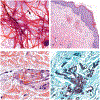Emerging and reemerging fungal infections
- PMID: 31010605
- PMCID: PMC11979780
- DOI: 10.1053/j.semdp.2019.04.010
Emerging and reemerging fungal infections
Abstract
Fungal infections throughout the world appear to be increasing. This may in part be due to the increase in the population of patients that are susceptible to otherwise rare fungal infections resulting from the use of immune modulating procedures such as hematopoietic stem cell transplants and drugs like tissue necrosis factor antagonists. Histoplasma capsulatum, an endemic fungus throughout North and South America, is reemerging among HIV+ patients in Central and South America and among patients taking tissue necrosis factor antagonists and other biologics in North America. Fusarium species, a relatively rare fungal infection, is reemerging worldwide in the immunocompromised populations, especially those who are neutropenic like hematopoietic stem cell transplant recipients. A new yeast species is currently emerging worldwide: Candida auris, unknown just a decade ago. It is causing large healthcare-associated outbreaks on four continents and is spreading throughout the world through patient travel. In this review the epidemiology, pathology, detection and treatment of these three emerging and reemerging fungi will be discussed.
Keywords: Candida auris; Fungi; Fusarium; Histoplasma.
Copyright © 2019. Published by Elsevier Inc.
Figures


References
-
- Richardson M, Lass-Florl C. Changing epidemiology of systemic fungal infections. Clin Microbiol Infect. 2008;14(Suppl 4):5–24. - PubMed
-
- Biologic drugs set to top 2012 sales. Nature medicineNat Med. 2012;18:636. - PubMed
-
- Wheat LJ, Azar MM, Bahr NC, Spec A, Relich RF, Hage C. Histoplasmosis. Infect Dis Clin North Am. 2016;30:207–227. - PubMed
Publication types
MeSH terms
Grants and funding
LinkOut - more resources
Full Text Sources
Medical

